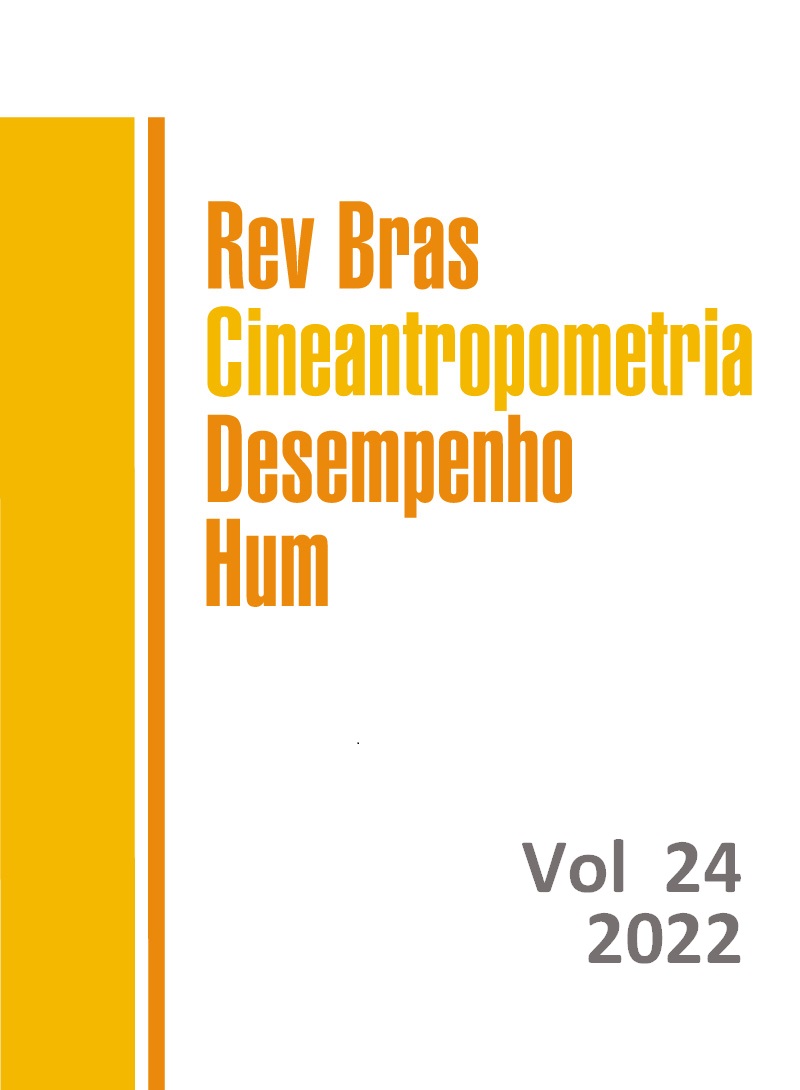Respostas fisiológicas de três métodos de treinamento de força em indivíduos treinados
DOI:
https://doi.org/10.1590/1980-0037.2022v24e87735Palavras-chave:
Treinamento de força, hipertrofia, desempenhoResumo
O treinamento de força é parte integrante dos programas de treinamento para estética, e desempenho esportivo. Embora experimentos comparem as respostas de alguns métodos, faltam estudos que analisem o tempo de execução, a recuperação e as percepções de dor e esforço. O objetivo do presente estudo foi avaliar e comparar as respostas metabólicas e fisiológicas do treinamento tradicional, drop set e restrição de fluxo sanguíneo em indivíduos treinados. A amostra foi composta por 16 homens treinados com idade entre 32 ± 10,5 e mínimo de 3 anos de prática contínua e regular de TF. Os dados foram coletados em 4 dias, sendo o primeiro atribuído ao teste de carga máxima e nos 3 dias seguintes analisamos aleatoriamente o drop set, restrição de fluxo sanguíneo e métodos tradicionais de treinamento. O lactato sanguíneo foi analisado após a sessão de treinamento. Circunferência do braço pré e pós-intervenção, frequência cardíaca e tempo total, escalas de percepção de dor e esforço, repetições e volumes totais. Os resultados não mostraram diferença significativa no número de repetições entre os métodos de restrição de fluxo sanguíneo e drop set, mas o volume total e o tempo foram significativamente maiores no drop set. O maior valor de lactato sanguíneo foi encontrado no drop set apesar dos outros métodos também apresentarem valores elevado. A restrição do fluxo sanguíneo e o drop set apresentaram diferença significativa em relação ao método tradicional na escala subjetiva de esforço pós-exercício, fato que se relaciona com o maior volume total, principalmente no drop set.
Referências
Guedes DP, Souza JR TP, Rocha AC. Treinamento personalizado em musculaçao. 1o Edição ed. [s.l.] Phorte, 2008.
Schoenfeld BJ, Grgic J, Krieger J. How many times per week should a muscle be trained to maximize muscle hypertrophy? A systematic review and meta-analysis of studies examining the effects of resistance training frequency. J Sports Sci. 2019;37(11):1286-1295.
Korak JA, Paquette MR, Brooks J, Fuller DK, Coons JM. Effect of rest-pause vs. traditional bench press training on muscle strength, electromyography, and lifting volume in randomized trial protocols. Eur J Appl Physiol. 2017;117(9):1891-1896.
Gomes AC. Treinamento desportivo: estruturação e periodização. [s.l.] Artmed, 2009.
Paoli A, Moro T, Marcolin G, Neri M, Bianco A, Palma A, Grimaldi K. High-Intensity Interval Resistance Training (HIRT) influences resting energy expenditure and respiratory ratio in non-dieting individuals. J Transl Med. 2012;10:237.
Prestes J, A Tibana R, de Araujo Sousa E, da Cunha Nascimento D, de Oliveira Rocha P, F Camarço N, Frade de Sousa NM, Willardson JM. Strength and Muscular Adaptations After 6 Weeks of Rest-Pause vs. Traditional Multiple-Sets Resistance Training in Trained Subjects. J Strength Cond Res. 2019;33 Suppl 1:S113-S121.
Fink JE, Schoenfeld BJ, Kikuchi N, Nakazato K. Acute and Long-term Responses to Different Rest Intervals in Low-load Resistance Training. Int J Sports Med. 2017;38(2):118-124.
Angleri V, Ugrinowitsch C, Libardi CA. Crescent pyramid and drop-set systems do not promote greater strength gains, muscle hypertrophy, and changes on muscle architecture compared with traditional resistance training in well-trained men. Eur J Appl Physiol. 2017;117(2):359-369.
Loenneke JP, Pujol TJ. The use of occlusion training to produce muscle hypertrophy. Strength Cond J. 2009; 31(3):77-84.
Teixeira, CVLS. Metodos Avancados de Treinamento para Hipetrofia. 2o ed. [s.l.] CreateSpace, 2015.
Lagally KM, Robertson RJ. Construct validity of the OMNI resistance exercise scale. J Strength Cond Res. 2006;20(2):252-6.
Borg G. Escalas de Borg para a dor e o esforço percebido. São Paulo: Editora Malone, 2000.
Schoenfeld BJ, Wilson JM, Lowery RP, Krieger JW. Muscular adaptations in low- versus high-load resistance training: A meta-analysis. Eur J Sport Sci. 2016;16(1):1-10.
Gentil P, Oliveira E, Fontana K, Molina G, Oliveira RJD, Bottaro M. Efeitos agudos de vários métodos de treinamento de força no lactato sanguíneo e características de cargas em homens treinados recreacionalmente. Rev Bras Med Esporte. 2006; 12:303-307.
Alves RC, Prestes J, Bueno JCA, Del Vecchio FB, Junior TPS. Comparação do gasto energético em diferentes métodos do treinamento de força. ConScientiae Saúde. 2018; 17(3):293-301.
Guimarães BM, Alves RR, Lopes LCC. Aplicabilidade do treinamento com oclusão vascular para incremento de hipertrofia e força muscular: estudo de revisão. Int J Mov Sci Rehabil. 2020; 2(1):4–15.
Baker BS, Stannard MS, Duren DL, Cook JL, Stannard JP. Does Blood Flow Restriction Therapy in Patients Older Than Age 50 Result in Muscle Hypertrophy, Increased Strength, or Greater Physical Function? A Systematic Review. Clin Orthop Relat Res. 2020;478(3):593-606.
Matheus BH, Pereira EB, Jerônimo DP. Análise da hipertrofia do bíceps braquial comparando os métodos de treinamento de força Drop set e oclusão vascular. Rev Bras Prescr Fisiol Exerc. 2019; 13(88):1332-1339.
Mota MR, Fonseca JEC, Barbosa S, Leite M, Silva AO, Aparecida R. Physiological and Hemodynamic Effects of Blood Flow Restriction Training on Quadriceps. J Exerc Physiol.2018;21(3): 79.
Muniz BR, Maia IS, Eiras AE, Camacho RO, Silva-Augusto P. O papel de duas sessoes extenuantes com diferentes intervalos entre as sessoes--24 e 48 horas--e o efeito protetor da carga. Rev Bras Prescr Fisiol Exerc. 2014;8(43):14-23.
Downloads
Publicado
Edição
Seção
Licença

Direitos Autorais para artigos publicados nesta revista são do autor, com direitos de primeira publicação para a revista. Em virtude da aparecerem nesta revista de acesso público, os artigos são de uso gratuito, com atribuições próprias, em aplicações educacionais e não-comerciais, desde que seja dada a atribuição. Esta obra foi licenciada com uma Licença Creative Commons Atribuição 4.0 Internacional - CC BY


